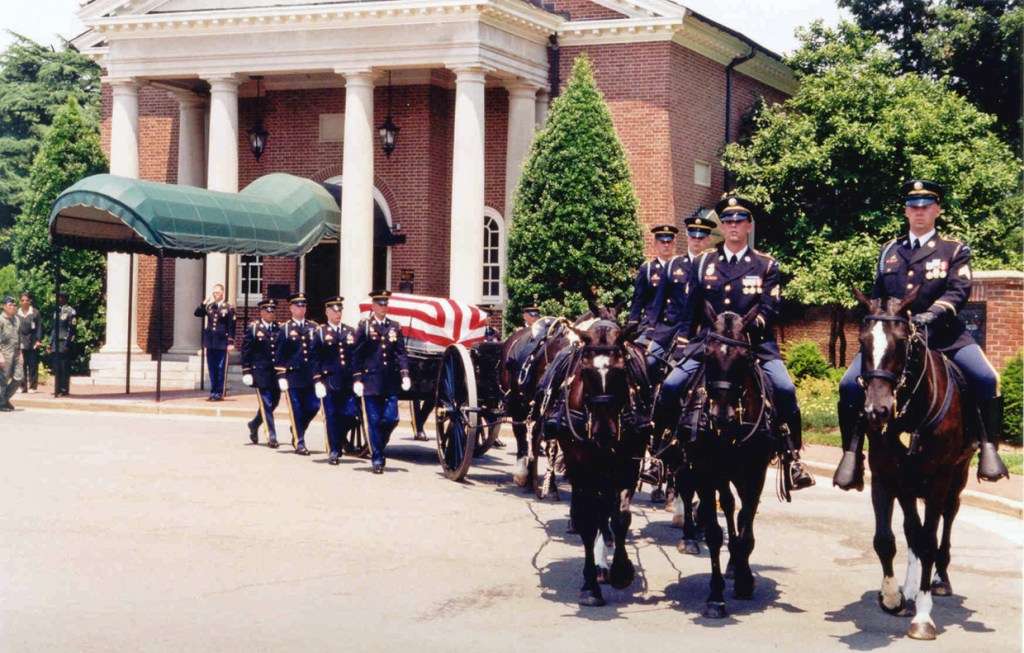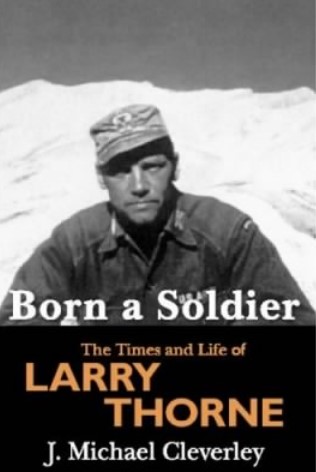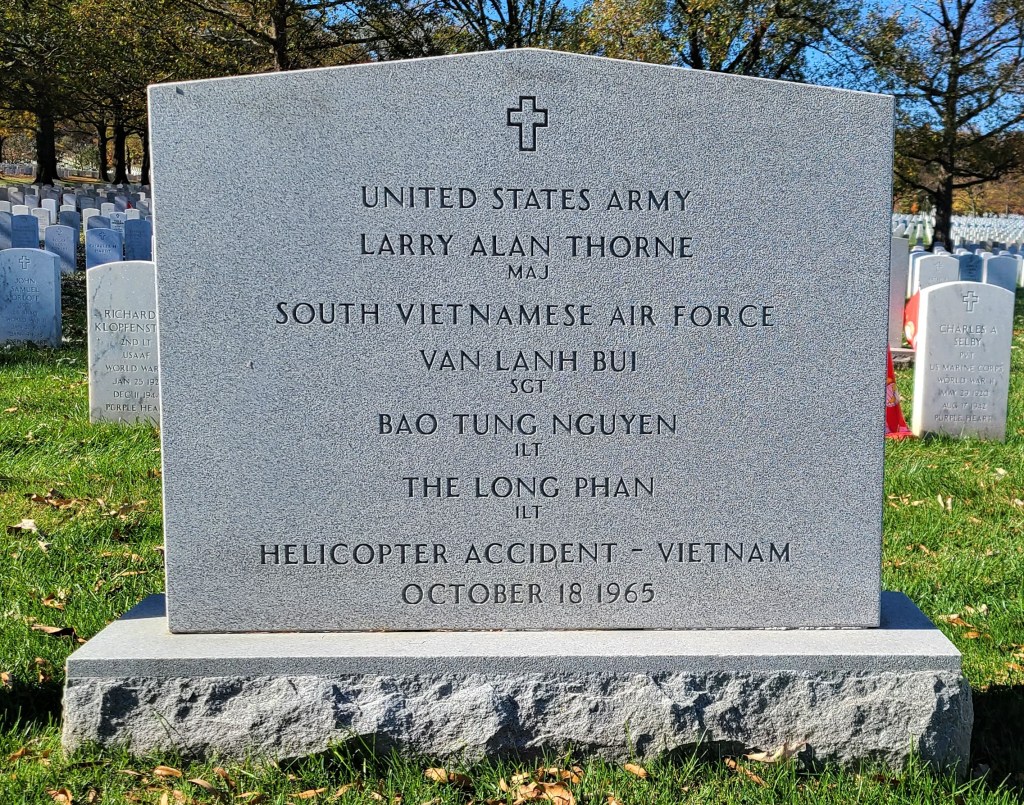May 28, 1919 (Viipuri, Finland) – October 19, 1965; 46 years old
Unmarried
Last local address: unknown (see WEBMASTERS NOTE below)
Enlisted on December 31, 1956
MOS: 3154, Infantry Unit Commander & Special Operations
Tour Start Date: January 18, 1965
Service number: O-2287104
Unit: Military Assistance Command, Vietnam – Studies and Observations Group (MACV-SOG), Team SD-5891
Casualty Location: Quang Nam Province, South Vietnam
Larry is on The Wall at Panel 2E, Line 126
Awarded the Legion of Merit, Distinguished Flying Cross, Bronze Star Medal, and Purple Heart Medal with 6 oak leaf clusters.

WEBMASTER’S NOTE: Despite efforts to contact the authors of the two books below and additional research, the only reference to why Major Thorne claimed Norwalk as his hometown is from the book Soldier Under Three Flags. On page 105, it says, “Torni had used the Norwalk, Connecticut address of his boss and friend, a Mr. Frederickson, as his military home of record.“
ADDITIONAL INFORMATION AND PICTURES FROM E-MAIL RECEIVED FROM KARI KALLONEN OF FINLAND IN 2022:
Yes, I have written several nonfiction books, and in 1999, I was one of the five Finns who took part in the Joint Task Force Full Accounting 56th Field Excavation with the Americans in Vietnam. If you wish, feel free to use the attached photos on your website.
Thorne’s last mission was Shining Brass, which was to track down the Ho Chi Minh Trail in Laos. The photo is of that mission. Though the operation went over the border, Thorne’s H34 crashed in Vietnam. At first, nobody knew what had happened; Thorne had just disappeared. Only in 1999, when we found the remains, was it confirmed to be a helicopter accident.
Before joining the Army Thorne worked on several constructions. In the fall of 1953, he came to Norwalk to work for Mr. Fredrickson. Thorne and his brother-in-arms, former long-range platoon leader Sulo Uitto, built several “model houses” in Norwalk 1953-1954. I presume these were wooden houses built with the same building plans, possibly of Finnish origin. Maybe some town registers have more information? The photo may be from Norwalk or from New York. Webmaster’s note: in the 1920 census, there was an Ida Frederickson living at 40 Wall Street in Norwalk. She had 4 sons living with her: Hubert, Walter, Harry, and Laurence.
Norwalk was Larry Thorne’s last civil address before his Army career, so I can confirm he was a town resident at the time. It is hard to determine the home town after that, as Thorne traveled from the U.S.A. to Norway, Iran, Italy, Germany, and Vietnam during his missions. Thorne did not have any relatives in the U.S.A., and now his sisters and brothers-in-arms have passed away, too. However, we managed to interview them, including Sulo Uitto, while they were still alive. END




There is an hour-long Finnish documentary with English subtitles of the legendary Finnish-American soldier Lauri Allan Törni — click HERE. Documentary link contributed by kariahola67@hotmail.com via e-mail in 2022.
Lauri Alan Törni was born in Viipuri, Viipuri Province, when Finland controlled it. In 1945, the region was finally ceded to the Soviet Union following the Winter War and Continuation War. He served with the Finnish and German armies in the wars against the Soviet Union. In 1950, he immigrated to the United States and joined the US Army in 1954 while residing in Connecticut. At that time, he changed his name to Larry Thorne. He joined the Army Special Forces (Green Berets) and was commissioned in 1957. In 1963, Thorne was a captain serving as an advisor to the Army of South Vietnam. Thorne died while on a clandestine mission in Laos.
Lauri Torni was known as the Soldier who fought under three flags. Lauri was born into a prosperous family in Viipuri, Finland. He was a Finnish Army Captain who led an Infantry Unit in the Finnish Wars and moved to the United States after the War, changing his name to his new American name of Larry Thorne. He fought for Finland and Germany during World War II. And America in the Vietnam War. He entered military service in 1938 at the age of 19. He continued his service in the Non-Commissioned Officers Reserve in Hamina until the beginning of the Winter War. Torni was originally assigned to supply troops, but during the battles at Lake Ladoga, he was transferred to the front lines. He took part in the annihilation of the encircled Russian Troops in Lemetti. After the War, in 1941, Torni was one of the men who was sent to Germany to train with Waffen-SS, but he soon returned home.
In 1943, he was assigned to an Infantry Unit that fought behind enemy lines. One of his men would be the future President of Finland, Mauno Koivisto. The Soviet Army had a Bounty on Lauri Torni’s head, worth 3 million Finnish Marks. On July 9th, 1944, he was decorated with the Mannerheim Cross. Torni was dissatisfied with the Peace Treaty and went back to Germany in 1945 for additional training. He was hoping to organize resistance against Russia if they tried taking Finland. He surrendered to British Troops in the last stages of the War and eventually escaped the British POW Camp, returning to his homeland of Finland. When he returned, the ValPo (State Police) arrested him, and he was sentenced to 6 years in prison, eventually pardoned by President Paasikivi of Finland in December of 1948.
In 1949, Torni traveled to Sweden, where many Finnish settled after the War. From Sweden, he traveled on the SS Bolivia to Venezuela. In 1950, he was hired on a Norwegian Cargo Ship, the MS Libre Villaan, and his destination was the United States. In the Gulf of Mexico, near Mobile, Alabama, he jumped overboard and swam to shore. He traveled to New York, where he got a job as a Carpenter and a Cleaner, with help from Finnish Settlers. In 1953, he was granted a permit of residence.
Lauri Torni joined the U.S. Army in 1954, where he changed his name to Larry Thorne. He ended up as a Special Instructor in the Special Forces Unit and taught skiing, survival, mountaineering, and guerrilla tactics; he also took up parachuting. From 1958-1962, he served in the 10th Special Forces Unit in West Germany. In November of 1963, he joined another Special Forces Unit, A-734, and was sent to Vietnam to fight in the Mekong Delta. He was decorated twice while there. In 1965, he was transferred to MACV-SOG, a training unit in Vietnam, as a military advisor. On October 18, 1965, he left on a routine mission, and his helicopter crashed 25 miles from the Da Nang. When the rescue crew arrived, they did not find his body. He either died in the crash or in battle the next day with the Vietnamese. He was 46 at the time of death. His remains weren’t handed over until March 15, 2002. He was formally identified on June 4, 2003, 38 years after his death. He was buried with full military honors in Arlington National Cemetery along with the remains of the South Vietnam Air Force personnel who died with him.
Distinguished Flying Cross Citation
AWARDED FOR ACTIONS
DURING Vietnam War
Service: Army
Rank: Major
GENERAL ORDERS:
Department of the Army, General Orders No. 33 (July 26, 1967)
CITATION
The President of the United States of America, authorized by Act of Congress, July 2, 1926, takes pride in presenting the Distinguished Flying Cross (Posthumously) to Major (Infantry), [then Captain) Larry Alan Thorne (ASN: O-2287104), United States Army, for heroism, while participating in aerial flight heroism against a hostile force while participating in an aerial flight on 18 October 1965 in the Republic of Vietnam. Major Thorne was the operations officer responsible for launching a small, combined reconnaissance patrol on an extremely hazardous mission into a suspected Viet Cong stronghold. Due to the extreme hazards attending this mission, including weather and enemy action, Major Thorne volunteered to accompany submission aircraft during the introduction of the patrol in place of the assigned individual. After delivering the patrol to the landing zone, Major Thorne remained with one aircraft in the immediate area to receive an initial report from the patrol on the ground. This report was mandatory since only the vaguest information was available about enemy disposition near the landing zone. If the patrol were immediately confronted by a superior force, Major Thorne would land and extricate the patrol under fire. This was done with total disregard for the inherent dangers and with selfless concern for the ground forces. In so doing, he exposed himself to extreme personal danger, which ultimately led to his disappearance and the loss of his aircraft. He had, however, guaranteed the safe introduction of the patrol into the area, the successful accomplishment of this mission, and had positioned himself to react to any immediate calls for assistance from the patrol. Due to Major Thorne’s efforts, the mission was accomplished successfully and contributed significantly to the overall mission of interdicting Viet Cong activities within the area. Major Thorne’s actions were in keeping with the highest traditions of the military service and reflect great credit upon himself and the United States Army.






In October 2021, the City of Norwalk, Connecticut, added Major Thorne’s name to the plaque of those who died during service in Vietnam. It’s a fitting final tribute to an exceptional soldier.


Major Thorne is buried in Arlington National Cemetery, 1 Memorial Drive, Arlington, Virginia; Section 60, Plot 8136. Photo by webmaster.

END

This was a crazy find….interesting character. Despite Being a German soldier, became a Major in USArmy…almost makes me want to read the book.
LikeLike
In a story above it states that he came to work in Norwalk for a Mr Frederickson and built several houses alongside his onetime long range platoon leader Sulo Uitto between 1953 and 1954 and that he used the Norwalk address of his boss Mr. Frederickson. it was his military home of record, that it was his last civil address before the army, that he was a resident at the time
LikeLike
You’re correct. I’m the one who maintains the pages. When I updated it with the information about Mr. Fredrickson, I forgot to delete my comment from 2 years ago. I have now. Thank you!!!
LikeLike